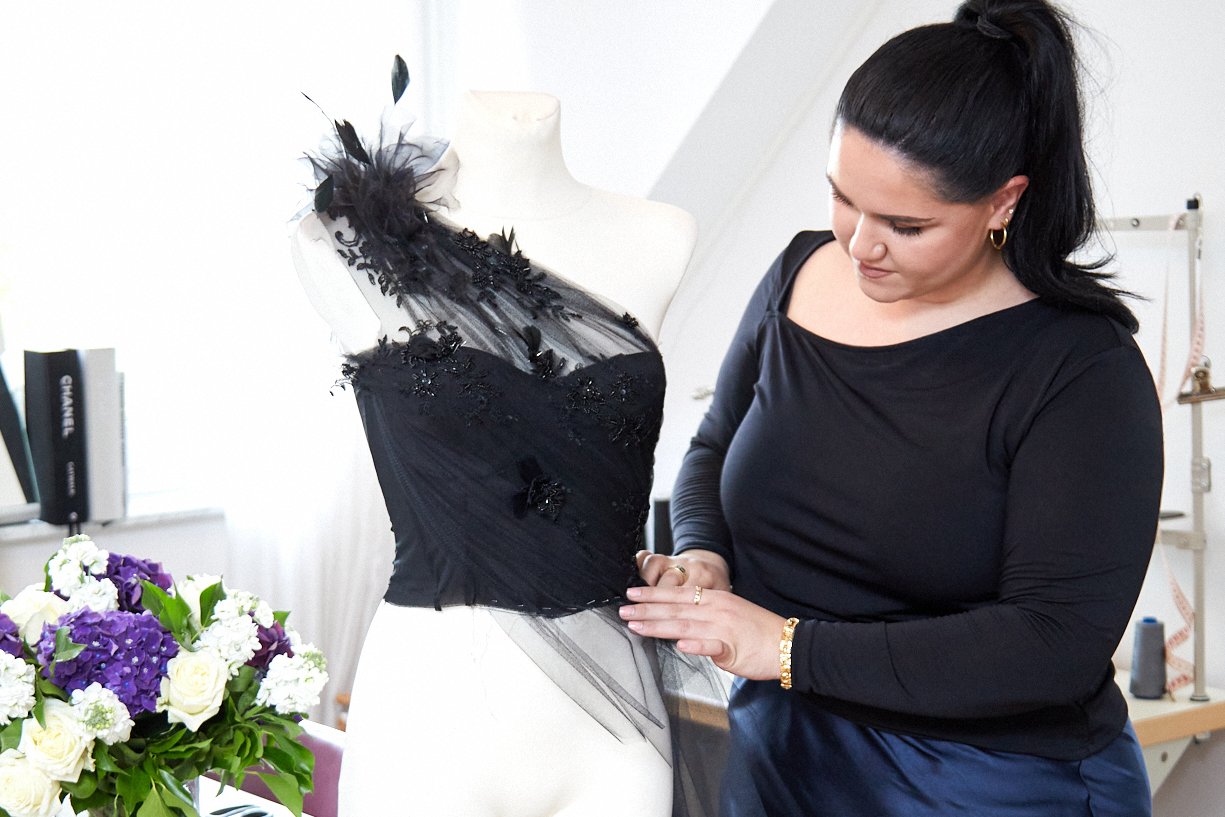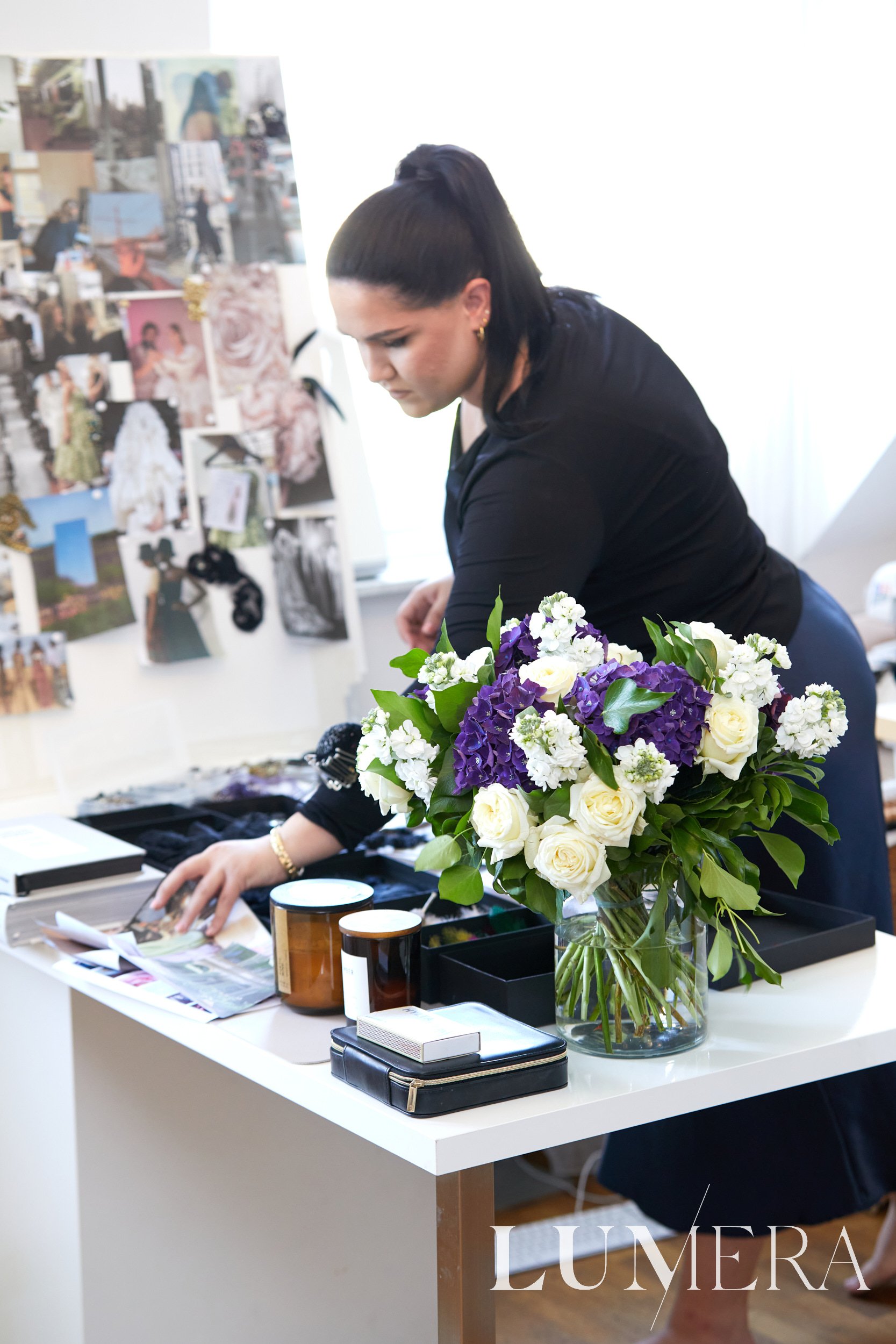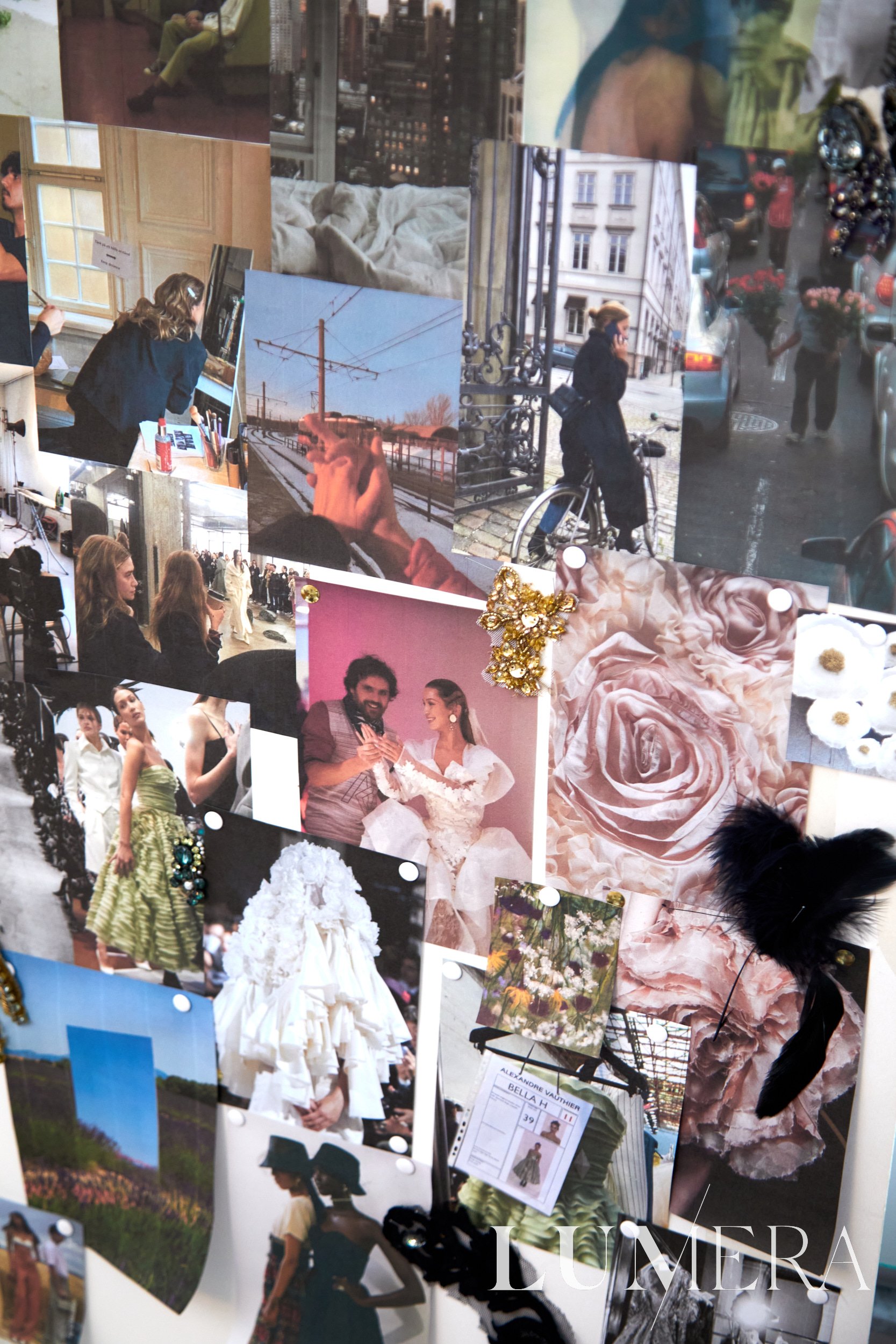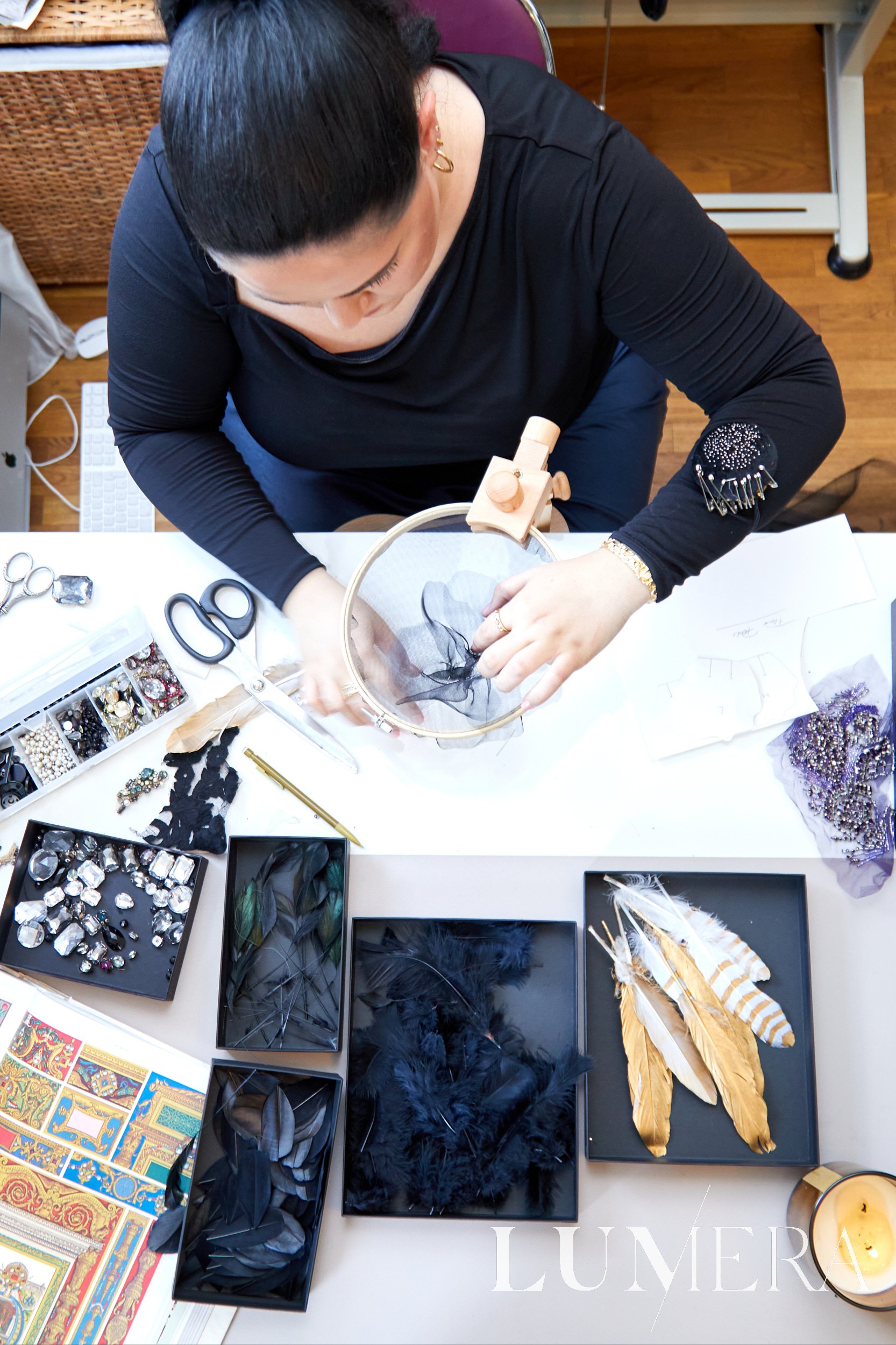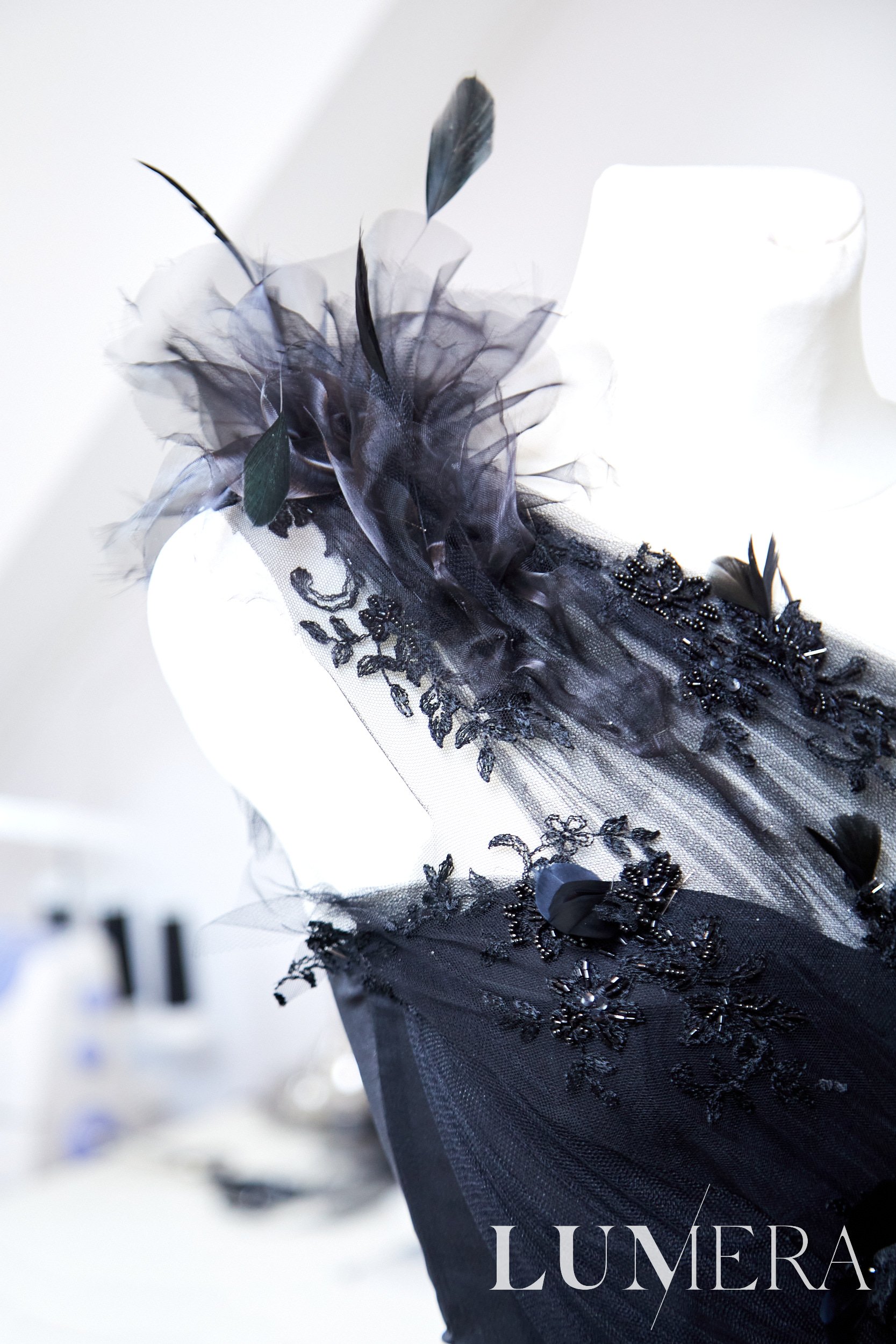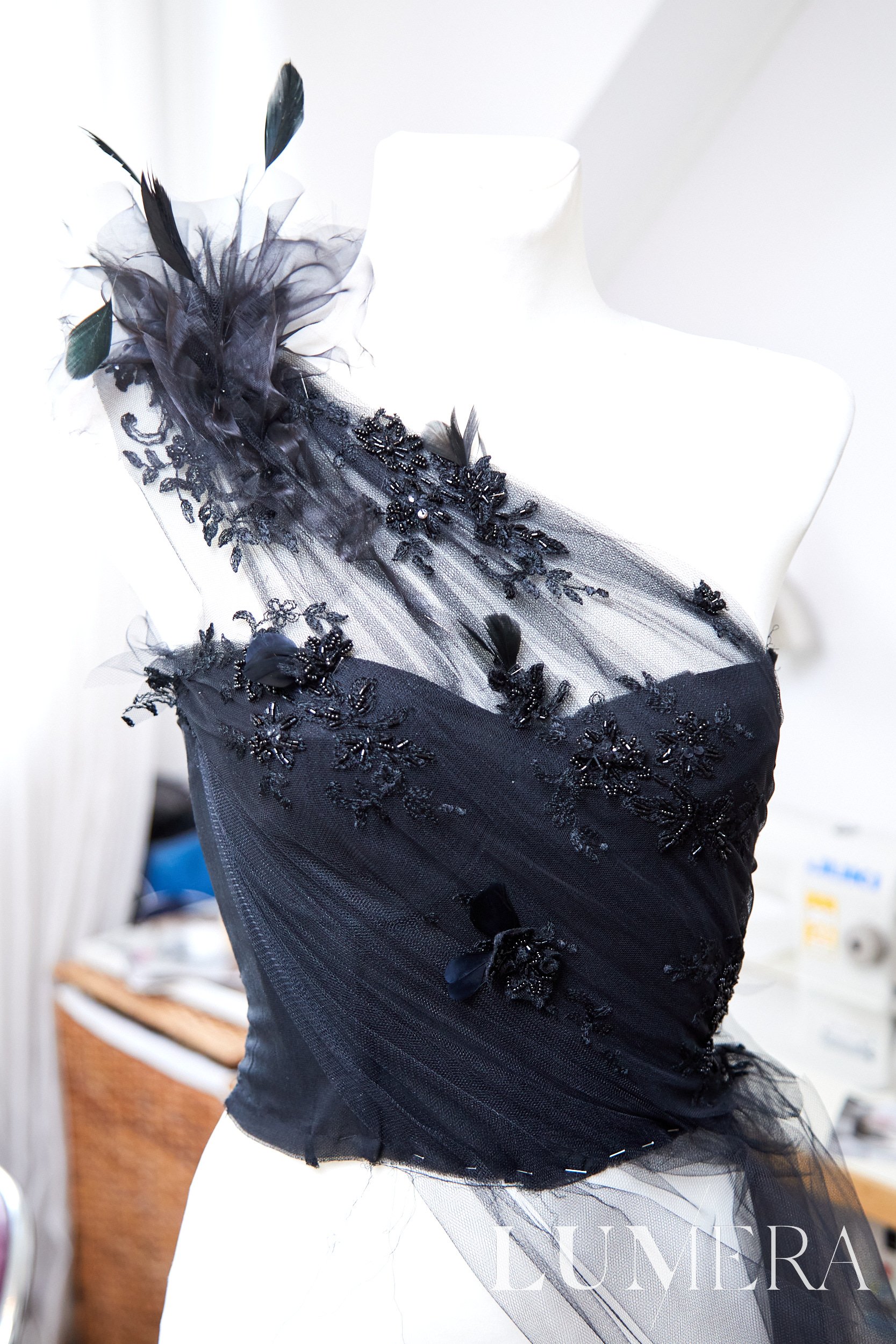Alina Ifraimova – The Flower Girl
HER ATELIER IS FILLED WITH FEATHERS, FABRICS AND PEARLS. MOOD BOARDS ARE FILLING THE WALLS, A MANNEQUIN STANDS TALL IN THE CENTER OF THE ROOM AND THE FLOOR IS FILLED WITH THREADS. I AM MEETING MY FRIEND ALINA IFRAIMOVA TO NOT ONLY TALK ABOUT HER WORK, BUT ACTUALLY SEEING HOW SHE IS DOING HER BEAUTIFUL FABRIC FLOWERS FIRST-HAND (SPOILER ALERT: THERE IS A VIDEO OF HER MAKING FLOWERS AT THE END OF THIS INTERVIEW). NORMALLY SHE DOES THIS FOR ONE OF THE LARGEST HAUTE COUTURE BRANDS IN NEW YORK. THERE, THEY CALL HER THE FLOWER GIRL.
words by SARAH MARIE FRANKEN
photographs by ANDREW DAY
Alina! Thank you for taking the time for this interview and for showing us how you work in person. Can you tell us more about what you do?
It’s my pleasure! I work for an Haute Couture company in New York and my specialty is creating 3D embroidery, mainly flowers made out of fabrics. I work with organza, velvet, feathers, pearls and more to create textures. The look is romantic. The brand I work for is very feminine, very dreamy, fairy-tale-inspired and that’s also the direction I love.
What is a “texture”?
A texture is a fabric manipulation. I start by cutting the fabric in different shapes and continue by draping it on a base, which is typically illusion tulle. You can manipulate a fabric through folding it, ironing it, steaming it and much more. Basically, you manipulate the fabric into different shapes like flowers, pleats or other 3D elements.
Do you have the choice what texture to create or do you get a specific task?
Most of the time I have the option to just design by myself. I can be very creative and free during the design process, which I really appreciate. My boss tells me for example: we want an a-shaped gown, this is the idea, that is the fabric. That’s when I start to work on texture options, new drapes and 3D-elements. It’s always teamwork between the designers and the atelier.
Who else works in the creative department at the Haute Couture brand?
There is the fabric research and development team which works with all the vendors to order the correct fabrics, the atelier with the sewers and pattern makers and the design team. Within the design team, there are the fashion designers and the embroidery designers. The embroidery team creates all the stunning embroideries and thread works. I specialize mostly on making the flowers - they also call me the flower girl. We work all together in one big room. It’s great to exchange ideas like this! I can hear the textile team place the order with the textile mills after they visited us to present their options for the new season and already know what’s coming.
How often do they come in to present new fabrics?
They come in right before each season. We have four seasons for the main collection and two seasons for the bridal lines each year. The main collection are Autumn/Winter, Resort, Spring/Summer and Pre-Fall. And the bridal line contains a Summer and a Fall collection. Before each collection we gather all ideas on mood boards. Here, it’s great to include photos not only from the web, but also images you took around you. I love the art galleries and museums like the MoMA in New York to find inspiration. And I take images of nature for my mood boards too.
Nice! Can you tell us more about the fabrics you use?
Mostly silk organza, tulle, lace or velvet. I choose the materials depending on the season. My favorite is satin face organza, it is a little heavier and gives a beautiful three-dimensional effect. Sometimes I also use tulle, it’s lighter, so you can really see the different flower petals. In the winter, velvet is beautiful! It gives an edgy look.
What kind of fabric flowers are there?
There are small ones and large ones. The smaller ones are applied as decoration. For example on a veil or the skirt of a dress. A large flower can cover a whole area, as you can see on the example piece that I made for us. The flower reaches over the whole corset.
How do you create the small flowers?
I start by deciding the size and fabric. Then I do the petals. There are also companies where you can order them from, but I like to cut them myself. I look up different flowers and trace the exact shape of their leaves. It’s fascinating how different the flower petals are in nature. I decide how many different sizes I will need and how many fabrics I want to include in the flower. Then I cut them out. To create the flower, I use an embroidery hoop. That’s the wood tool you can see on the photos. In the circle I put illusion tulle which works as the base. This special kind of tulle is more resistant. On that base I create the flower which will be cut out from the tulle at the end. I start with folding the bottom edges of the petals inwards to give them a rounded shape. Now, you bring all the petals together. Start at the outer edge and work inwards. You sow petal by petal on with a few stitches. As the last step I cut a circle for the finishing in the middle. You just fold it in half, swirl it and sow it in the center. One night I had to stay longer because of some last-minute preparations for a shoot and I made about 50 feather flowers!
“For the peTals I look up different flowers and trace the exact shape of their leaves. It’s fascinating how different the flower peTals are in nature.”
Alina Ifraimova
That’s crazy! And when do the feathers and pearls come in?
At the end for decoration if needed! You can bring in different crystals, feathers, pearls, stones, sequins or other little 3D elements that will sparkle it up a little . I love working with duck feathers, they are more curved. You can also achieve the look by ironing other feathers. At work I have this cute mini-iron for that. It gives the feathers a little curve. Ostrich feathers are beautiful too, they’re long and perfect for the center.
What do you love most about working in couture?
I think it is very personal, Couture is made with a lot of love, just seeing all the people that put in all the work into one dress, to bring it all together, is very inspiring to me. Especially seeing that happening with the bridal dress is so special. There is so much more than what the clients see at the end. It’s not just a good designer that stands behind a good dress. It’s a good pattern maker, good sewers, good embroidery makers, they all are very important. What they do is just art. The first time I saw a corset they made, I was amazed. This is real Couture.
I love what you said: it’s made with love. And I think you can feel that when you wear a garment.
Yes. These garments really have a soul. It’s a difference that you can really feel when you wear one of these dresses!
What do you think about fast fashion?
I think it’s sad how they reproduce so much and they don’t give other brands the chance to bring out their new, unique pieces. Companies like H&M or Zara see the fashion shows and make cheap copies. The original garments from the big designers are only in stores six months later. And by then they look uninteresting to the clients, because they have seen the design elements in a lesser quality version already at the fast fashion stores. They are so quick – it really should not be like this. They steal the creativity from others and make profit of it.
This is one of the reasons I stopped buying from fast fashion companies. What’s another advantage of buying handmade pieces?
You can show your individuality. No one is going to own the exact same garment. Another big difference is the fit. Cheap productions have to do many items in a short amount of time. They produce an item in a small size and then just reproduce the same proportions in bigger sizes. But the human body doesn’t work like that. You can’t just grade the sizes. And this goes not only for fast fashion. Some more expensive companies market themselves differently and pretend to have a better production than they actually do. Of course, buying Haute Couture for everyday life is not the answer. But there are a lot of smaller brands with a more thoughtful and sustainable process who put love into what they do. There is the French brand Maison Cléo for example. It is a mother daughter duo: the mother is sewing everything and the daughter is the designer. The pieces are named after women in their family and are made of only natural fabrics. They work very transparent and show you every single step on the website. They have nothing to hide. They make the customers understand what they are paying for. You’re going to feel different wearing a piece with a background story like this!
“buying Haute Couture for everyday life is not the answer. But there are a lot of smaller brands with a more thoughtful and sustainable process who put love into what they do.”
Alina Ifraimova
Absolutely! This is a great example. I read the other day, that within the last few decades fashion went from a treasured possession into a cheap disposable object. Buying at brands like Maison Cléo could be the beginning of a change in mindset.
Totally! I think it also has to do with the prices. I can see this in my own behavior, if I buy something that is more expensive, I treat it in different way. I take care of it better. I don’t throw it on the floor when it is dirty and I have it dry-cleaned. Also, I keep it longer whereas fast fashion items leave my closet quickly. They look like I already wore them for five years after washing them three times because they are just not made to last.
That makes sense. Another question, is there something you would like to change about the fashion industry right now?
I wish there would be less seasons. Even as an Haute Couture brand, the buyers expect something new from us every two months. I think that is too much. Why do we need all that? There is too much fashion being produced. I think this is something the whole industry is thinking about during the pandemic. And I hope this is something that will change.
I really hope the slowing-down of the industry is the change we are going to see from here on forward!
Another change I’d like to see is that companies within the fashion industry don’t expect 24/7 availability for the employees. A friend of mine said in an interview that she wants to have a work life balance, and she saw the interviewer making a note. That turned out to be why she didn’t get the job. People in the fashion companies need to be allowed to have a private life. Just because they want to live their passion, they shouldn’t have to give up everything else.
It has to! That’s also what I thought when I watched the Alexander McQueen documentary recently. For the last question I ask everybody the same thing: Is there any topic, person or brand within the industry that you would like to shine a spotlight on?
There are so many wonderful men and women behind the creation of a dress, I wish the spotlight would be more on all of them. Our head of pattern making always says that she is a designer as well. And I totally agree! Draping up a gown is design. Designing means to decide how something will look like. And they create these beautiful, extravagant dresses out of a piece of fabric. That is so impressive to me. That’s something I love about Valentino, after the show they bring the sewers and all of the designers on the stage – because everyone counts! Often you just see the head designer, but there are so many people behind who do an amazing job! I am always most impressed with the pattern makers and the sowers. Not a lot of people talk about them, but they are so important. I would love to shine a spotlight on all these men and woman working by hand, working with expertise and love.
“That’s something I love about Valentino, after the show they bring the sewers and all of the designers on the stage – because everyone counts!”
Alina Ifraimova

